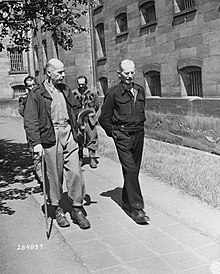Wilhelm List
This article needs additional citations for verification. (February 2013) |
Wilhelm List | |
|---|---|
 List as General | |
| Born | 14 May 1880 Oberkirchberg, Kingdom of Württemberg, German Empire |
| Died | 17 August 1971 (aged 91) Garmisch-Partenkirchen, West Germany |
| Buried | |
| Allegiance | |
| Years of service | 1898–1942 |
| Rank | |
| Commands held | 14th Army 12th Army Army Group A |
| Battles/wars |
|
| Awards | Knight's Cross of the Iron Cross |
| Signature | |
Wilhelm List (14 May 1880 – 17 August 1971) was a German
Following the war, List was charged with war crimes and crimes against humanity and stood trial in the Hostages Trial of 1947. He was convicted and sentenced to life imprisonment. List was released early for poor health and died in 1971.
Early years
List, born in Oberkirchberg in Württemberg in 1880, the son of a physician.[1] He entered the Bavarian Army in 1898; in 1913 he joined the Bavarian General Staff.[2] He served as a staff officer in World War I (1914-1918). List spent four years at the front as commander of an infantry regiment, where he had as one of his subordinates then Corporal Adolf Hitler.[3] After the war, List stayed in the Reichswehr. In 1922, he became commander of an Alpine battalion. Called to the Defense Ministry in 1926, he was made director of military education, later commander of Dresden Infantry School. [4] By 1932, he was promoted to Generalleutnant. In 1938, after the Anschluss of Austria with Germany, List had the task of integrating the Austrian Armed Forces into the Wehrmacht.
World War II
In 1939, List commanded the
Invasion of France
During the huge German offensive against France and the Low Countries May to June 1940, the 14th army remained in Poland, but this was not the case with its commander. In May 1940 List commanded the 12th German army during the fall of France. The 12th army was a unit of the German Army Group A, under command of Gerd von Rundstedt. It was this Army Group that successfully forced the Ardennes and then made the imperative break-through on 15 May 1940, which spread panic in the French forces and cut the British expeditionary forces off from their supply lines.
After this successful campaign List was among the twelve generals that Hitler promoted to
Invasion of Greece and Yugoslavia

On 6 April 1941 the Wehrmacht launched invasions both of Greece and of Yugoslavia. List's 12th Army, consisting of four armored divisions and 11 motorized infantry divisions, totally outmatched the defending forces. German forces occupied Belgrade on 13 April and Athens on 27 April. The mainland Balkans campaign ended with the evacuation of British forces on 28 April. In the Balkans List became implicated in the mass murder of hundreds of thousands of civilians by having ordered hostage-taking and reprisal killings.
Summer campaign of 1942 and dismissal
In early July 1942, List took command of
However, by the end of August their advance had ground to a halt, chiefly due to considerably stiffened Soviet resistance, and also due to critical shortages of fuel and ammunition as the army group outran its supply lines. Matters were made worse for the Germans by the removal in mid-August of most Luftwaffe combat units to the north to support the 6th Army’s drive on Stalingrad.[citation needed]
Hitler was angered by the loss of momentum. He sent
Hostages trial

List was arrested by the Allies after the war. In 1947, List and 11 former subordinates were charged with
Awards
- Wound Badge (1918) in black[8]
- Iron Cross (1914), 1st and 2nd class[8]
- Clasp to the Iron Cross (1939), 1st and 2nd class
- Knights Cross of the House Order of Hohenzollern with Swords[8]
- Knight's Cross of the Iron Cross on 30 September 1939 as Generaloberst and commander-in-chief of the 14. Armee[9][10]
- Military Merit Order, 4th class with Swords and Crown (Bavaria)[8]
- Knight's Cross of the Friedrich Order (Württemberg)[8]
- Military Merit Cross, 3rd class with war decoration (Austria-Hungary)[8]
- Knight's Cross of the Order of Military Merit (Bulgaria) (Bulgaria)[8]
References
Citations
- ^ "German Generals: Brief Who's Who of the High Command of Nazidom's Army". Life Magazine. November 13, 1939. pp. 39–43.
- ^
Compare:
Stumpf, Reinhard (1985). "Deutsche Biographie" (in German). Retrieved 3 November 2022.
Im Okt. 1908 begann für ihn mit dem Kommando zur Kriegsakademie in München die Generalsstabslaufbahn. Nach dem erfolgreichen Abschluß der Akademie (1911) Zugführer im 1. Infanterieregiment, probeweise im Generalstab und Kompaniechef im 1. Pionierbataillon, wurde L. am 19.3.1914 in die Zentralstelle des Generalstabs in München versetzt (1913 Hauptmann).
- ^ "German Generals: Brief Who's Who of the High Command of Nazidom's Army". Life Magazine. November 13, 1939. pp. 39–43.
- ^ "German Generals: Brief Who's Who of the High Command of Nazidom's Army". Life Magazine. November 13, 1939. pp. 39–43.
- ISBN 9781473833869.
- ^ Archived at Ghostarchive and the Wayback Machine: "The Turning Point? BATTLESTORM STALINGRAD E16". YouTube.
- ^ Archived at Ghostarchive and the Wayback Machine: "The Turning Point? BATTLESTORM STALINGRAD E16". YouTube.
- ^ a b c d e f g Rangliste des Deutschen Reichsheeres (in German). Berlin: Mittler & Sohn. p. 184.
- ^ Scherzer 2007, p. 510.
- ^ Fellgiebel 2000, p. 294.
Bibliography
- Fellgiebel, Walther-Peer (2000) [1986]. Die Träger des Ritterkreuzes des Eisernen Kreuzes 1939–1945 — Die Inhaber der höchsten Auszeichnung des Zweiten Weltkrieges aller Wehrmachtteile [The Bearers of the Knight's Cross of the Iron Cross 1939–1945 — The Owners of the Highest Award of the Second World War of all Wehrmacht Branches] (in German). Friedberg, Germany: Podzun-Pallas. ISBN 978-3-7909-0284-6.
- Hayward, Joel S. A. Stopped At Stalingrad. University Press of Kansas; Lawrence: 1998. ISBN 978-0-7006-1146-1.
External links
(In German)
